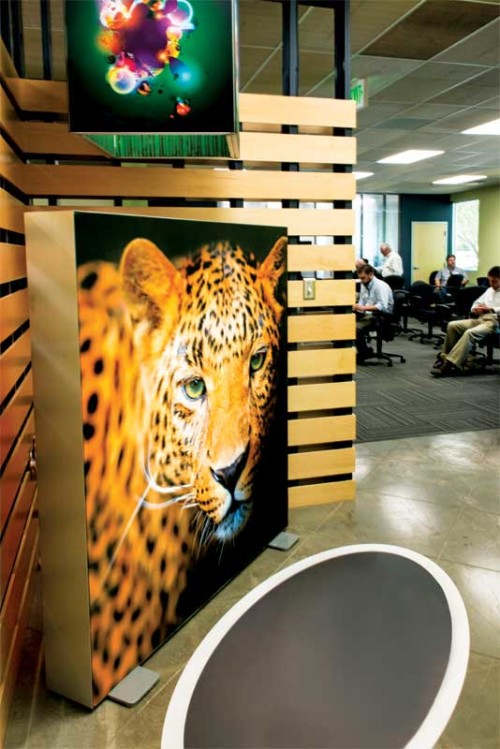
A grand-format printer may take up less space within a production facility than two wide-format printers side-by-side.
The soft touch
Another area of rapid innovation has been fabric printing in general, where InfoTrends predicts a compound annual growth rate (CAGR) of 39 per cent for the next few years.
One of the primary factors influencing how textile graphics are used is the arrival of more European retailers in the North American market. Fabric point-of-purchase (POP) displays have increasingly become the industry standard in Europe over most of the last decade due to their beauty, elegance and sophistication and now there is a similar trend hitting Canada and the U.S. Large, backlit fabric displays have proven particularly impressive and eye-catching for merchandising purposes. Perhaps not surprisingly, fabric graphics have had a tremendous impact on the trade show exhibitry market. Other opportunities in growing markets include the digital printing of garments, interior décor and industrial textiles.
With the dramatic growth of digital textile printing in North America has come an increased demand for dye sublimation technology in the wide-format graphics industry, from apparel to soft signage. As more customers recognize the advantages of superior dye-sub output, more PSPs are adopting the print production equipment behind it.
One of the primary advantages of dye sub is how it allows fabric to maintain its feel or ‘hand.’ When the ink is sublimated onto the substrate, it is infused into the fibres—as opposed to pigmented inks, which are only deposited onto a fabric’s surface—to achieve a deeper level of saturation and, thus, richer colours, adding to the ‘high-end’ look of the final product, which remains as soft as before printing.
Another important benefit of the ink being infused directly into the fabric is image permanence without needing any additional surface protection. The image cannot be washed away, rubbed off or otherwise removed from the fabric, in contrast to textile graphics printed using solvent-based, UV-curable or latex inks.
In Europe, given the high market demand for fabric-based retail graphics, it is not uncommon for sign shops to operate both dye-sub and UV printers, so they can choose the right technology for each application. In North America, approximately one in eight facilities use both of these technologies, but the number is rising as the printed textile market continues to become stronger.

Framing systems have been specially designed for backlit fabric graphics.
Wide to grand
This raises another challenging question for today’s PSPs to face: when is it best to operate (a) two wide-format printers side-by-side or (b) a single grand-format printer?
Arguments can certainly be made for both options and the ultimate choice will come down to the sign shop owner’s preference, but there are significant advantages enjoyed today with grand-format printers, particularly in terms of streamlining a business.
For one thing, industrial grand-format printers—i.e. 2.5 m (100 in.) and wider—are faster. A single grand-format printer will generally produce output 30 to 50 per cent faster than the cumulative efforts of two standard wide-format printers that are running side-by-side instead.
For another, there is the question of footprint. A grand-format printer may actually take up less space in a production facility than two wide-format printers, given the need for adjacent allowances for loading and maintenance.
Finally, there are issues of productivity. Besides the speed and size differences, an industrial printer is built to run 24-7, whereas many commercial-grade wide-format printers are only intended to run six to eight hours a day. Some grand-format presses offer dual-roll printing, enabling two completely separate jobs to be printed on two different substrates at the same time, faster than could be achieved with two wide-format machines. And with a single printer comes more consistent ink placement from job to job, rather than worrying about ink batch differences between two side-by-side wide-format printers.
Of course, all of these factors must be weighed against each other on a shop-by-shop basis, taking into consideration the types of applications to be handled, the production workflow space and the electrical requirements of each machine, not to mention long-range budgeting and business goals.
Whatever stage of business a PSP is at, though, it will be important to keep abreast of ever-changing technologies and trends and be willing to make updates as new demands arise. Only companies taking this approach will reach and remain at the forefront of the industry, enjoying growth in their success and profitability.
Greg Lamb is CEO of Global Imaging, which sells wide-format, super-wide-format and grand-format digital textile, latex and UV-curing flatbed printers and supplies.. For more information, visit www.globalimaginginc.com.





